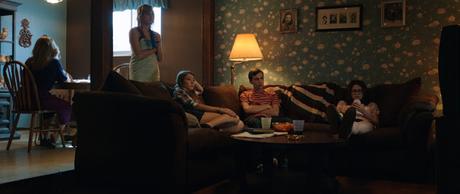
Hugh: Okay, even though it is following you I can still see it. It is not done with me either. Okay, like I told you, all you can do is pass it on to someone else.
Kelly Height: What the fuck are you talking about?
Hugh: She can do the same thing I did. It should be easier for her, she is a girl. Any guy would be with you. Just sleep with someone else and tell him to do the same thing. Maybe it will never come back.
It is hard to pin down where the lasting and haunting greatness of It Follows lies, the core of why it reverberates and stays with the viewer after the final scene. Director David Robert Mitchell relies on gorgeous cinematography capturing the odd beauty of Detroit, between the suburbs and the inner city, and a soundtrack that underlines a feeling of dreaminess throughout the film. He quotes deliberately from both the horror and the teenage movie genre, yet manages to combine the two into something that feels entirely new. It Follows escapes being placed in any particular time, and aesthetically, it fluctuates between Sixties and Seventies suburban living rooms, the visual and musical language of the Eighties and gorgeous science fiction elements, like the personalised seashell e-reader on which one of the character’s is reading, and amply quoting from, ‘The Idiot’. It Follows also features a unique central horror, unique both in its horribleness and in the nature of how it is evoked and transmitted. The curse is transmitted through sex, but the film undermines the usual horror film notion of sex=death, because sex is also the salvation. Jay catches it from her new boyfriend Hugh, but he explains to her how the curse works – something will relentlessly follow her, assume features of her loved ones and strangers, twist and turn things that she knows. It will not stop, unless she passes on the curse to someone else. The very nature of the curse creates an odd structure of mutual dependence, because if the person that it is passed on to dies, the horror moves on to the next one down the line. It calls for a selfish betrayal to save the carrier, but at the same time a conversation and sharing of facts to make sure that the next person is prepared and able to escape on her own. The choice of who to sleep with next, and how to prepare them, becomes a strategic essential element in your own survival. All of this is new, if based on existing horror movie tropes, but what then creates the uniqueness of the film is how heroine Jay chooses to proceed. The horror, the relentless following, haunts her quickly, disturbing the tranquil dreamlike everyday reality of living in the suburbs, hanging out with her friends, and it blurs the lines in the sand of what she and her friends are meant to be doing in that situation. It’s a stand-out because the curse is so focused on her, nobody else that she hasn’t slept with is in danger, and yet, because this is also a film about a group of teenagers who are bonded together by love, friendship and family, a scooby gang of sorts forms to find ways to beat the curse in ways that do not put a new person in danger and perpetuate the cycle of horror. That scooby gang becomes the heart of the film, because of their readiness to believe in the horror that they cannot physically see to protect their friend. They cross the literal line through their city in order to escape, flee into cabins and the ruins of the city, devise strategies that fail at a high cost – Jay passes it on to a friend, who thinks he can beat the curse but doesn’t – and in the end, they realize that the only way to be done with it for good, without the loss of their heart and soul, is to confront the horror directly rather than escaping it by playing by the inherent rules. The denial of passing it on the way it was meant to be, and therefore keeping it alive, is when they become unlikely heroes, creating a plan together and executing it. There is a reason why it works so well in the suburban setting of Detroit – the nature of the curse means that the best option to avoid death is to pass it on to someone as quickly as possible, and to make sure that this someone also passes it on as quickly as possible, but ideally also as far away as possible. The suburbs are insular – the boy who infects Jay is an outsider, assuming a fake identity just for the sake of his strategy in all of this – and once Jay has the curse, by the virtue of how the suburbs work, the next person infected is much more likely to be someone she already knows. The horror of the curse is so effective because it would be devastating in an insulated community, and that is exactly why it has the other effect of forcing the kids out of their parent’s houses and rules and into a different world, so close and yet always forbidden to them. That way, the curse works not only as the central horror, but also a trigger for a coming of age story about transgressing and escaping from their parents (here mostly unseen, if not used as a puppet for the curse).This contrast between the relentless, inescapable, perpetuated horror – the literal inevitable death, not rushing and precisely so scary because it has no reason to, and the strength of these kids standing up against it and beating the central premise that the only way of escaping is to implicate and infect someone else – is what makes It Follows so outstanding.
2014, directed by David Robert Mitchell, starring Maika Monroe, Keir Gilchrist, Lili Sepe, Olivia Luccardi, Jake Weary, Bailey Spry.

